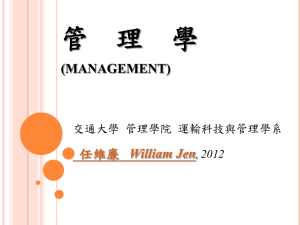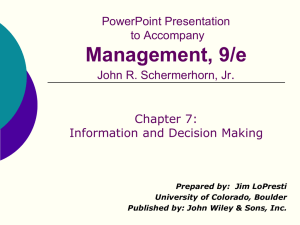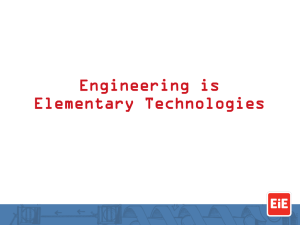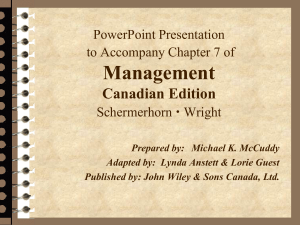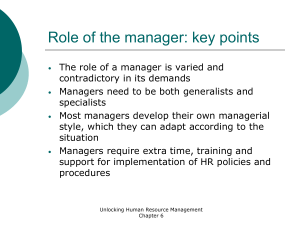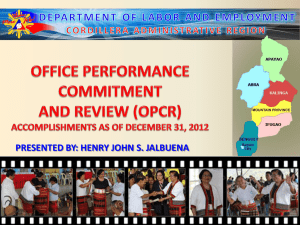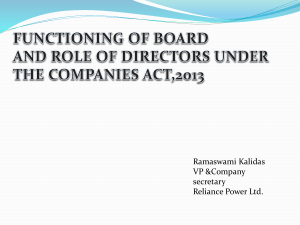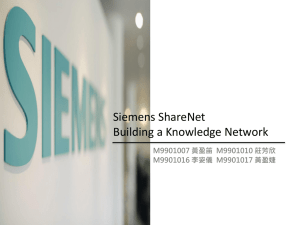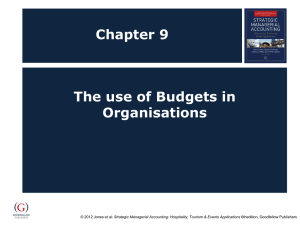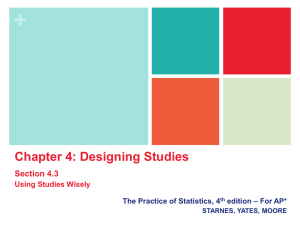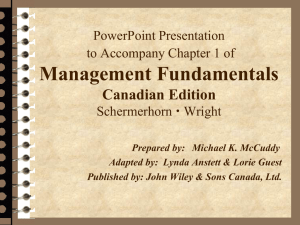中英文標點、符號、打字、排版須知 鍾 博 中文是很完美的文字,古文
advertisement
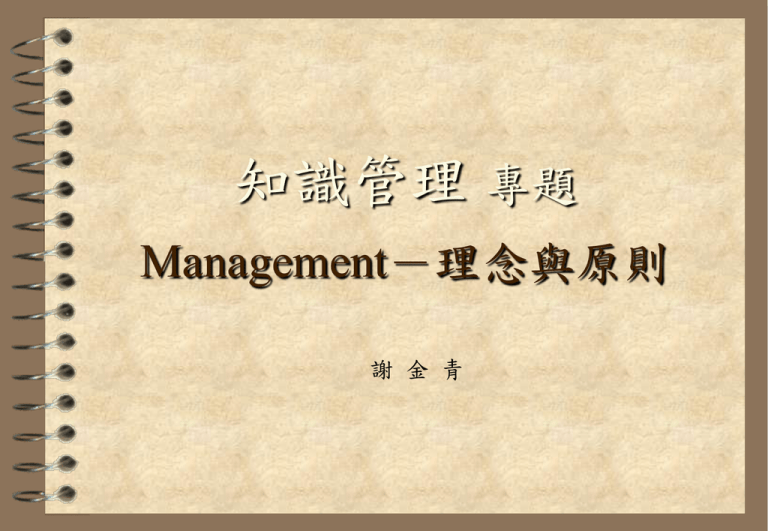
知識管理 專題 Management-理念與原則 謝 金 青 What is management Definition of management American management 1980: (AMA)—Management is getting through other people. Association things done Current: management is working with and through other people to accomplish the objectives of both the organization and its members. What are the differences between the two? Places greater emphasis on the human being in the organization. Focuses attention on the results to be accomplished, on objectives, rather than just things or activities. Adds the concept that accomplishment of the members’ personal objectives should be integrated with the accomplishment of organizational objectives. Discussion 暗示? 啟發? 未來? The managerial role president Managerial functions Manager’s Level in the organization technical functions first-line supervisor 0% Time 100% Discussion 校長如何扮演 manager? 主任如何扮演 manager? 教師如何扮演 manager? Introduction to the management process Define the problem. Set objectives. Assign responsibilities and delegate authority. Allocate resources. Design controls (work plans, milestone ) Monitor progress. Solve problems along the way. appraise performance. Personal competencies for managerial success Leadership- Self-objectivity Analytical thinking Behavioral flexibility Oral communications Written communication Personal impact Resistance to stress Tolerance for uncertainty Discussion 依上述標準自我檢測? Levels of decision-making in an organization Decision type Top Midlevel Supervisory level Strategic Administrative Operational The management process-1 planning- Strategic planning Setting goals Operational planning Defining objectives Designing the organization in the best way to achieve the goals and objectives Assigning responsibilities Allocating resources Designing organizational controls The management process-2 Controlling--Management control Developing individual standards Designing project controls Motivating Monitoring Reviewing progress Solving problems Coaching and counseling Performance appraisal The management process-3 Evaluation feedback to the next cycle Discussion 目前位階與作為的檢討? 未來角色扮演與行動之道? 管理摘要1:摘自Joan Magretta : What Management is? 管理是-將複雜的情況和高度的專業轉 成績效表現。 讓組織成員達到眾志成城、無堅不摧的 境界,往往是管理領域最具挑戰性的任 務。 阻礙組織創新最大的絆腳石,是人們不 願意釋放已經不能對成效帶來貢獻的能 力和資源。 管理摘要2:摘自Joan Magretta : What Management is? 價值愈是無形,我們愈應體認到,價值 是由顧客界定的。惟有滿足顧客需要, 一個組織才算有了績效表現。 管理的主要責任之一,就是要讓組織成 員記得,關心的重點是在組織外部,並 常相提示,他們從未忘記其原始承諾。 管理摘要3:摘自Joan Magretta : What Management is? 非營利組織(如學校)最難管理,因為 其經濟價值難以界定,缺乏明確的回饋, 組織績效也不易衡量。 非營利組織存在的目的不在於創造財務 利潤,因此要專注於使命感,而非僅僅 只在乎市場或者是顧客。 缺乏市場紀律的環境下,非營利組織必 須以使命紀律取代之,以幫助管理階層 學習由外而內思考。 管理摘要4:摘自Joan Magretta : What Management is? 非營利組織管理教義問答: 我們的使命是什麼? 我們的組織創造的獨特價值是什麼? 誰是組織使命達成的協助者,如何讓其利益 和組織使命相輔相成? 如何兼顧組織使命與顧客的價值需求? 管理摘要5:摘自Joan Magretta : What Management is? 經營策略與模式 : 每一個成功組織的經營模式在當時都是革命性的。 一個經營模式之所以成功,是因為它提出比現有經 營模式更好的做法。 成功的非營利組織具備優秀經營模式的要素:定位 清楚的角色、合理的動機群聚、發展一段有意義情 節。 伐木工人與將軍有不同的思維:伐木工人砍伐樹幹 時,並不擔心樹幹反擊;將軍發起攻擊,則要考慮 可能的抵抗。 管理摘要6:摘自Joan Magretta : What Management is? 最強而有力的管理原則之一:讓組織的 目標具體化,將任務轉化為一組目標和 績效評量標準,讓成功的定義變得具體 明確。 教育組織多半對「投入」的了解高於對 「結果」的了解。改善教育品質的方法 是,大家必須認同組織目標,然後將目 標轉化成具體的績效指標。 管理摘要7:摘自Joan Magretta : What Management is? 人資管理的最高境界就是不用管理。績 效最佳的人往往是那些懂得自我管理, 而且也會自我管理的人。管理的責任之 一,就是要提供一個讓人們能夠自我管 理的價值脈絡,讓個人能夠為自己的績 效負起責任。 塑造文化非常花時間,需要溝通、溝通、 再溝通。優秀的領導者才能創造獨特的 文化,才能有歷久不衰的價值脈絡,以 指引並激勵員工。 管理摘要8:摘自Joan Magretta : What Management is? 管理本質的核心是- 無上的樂觀與自信。 沒有不能解決的問題,也沒有 改善不了的現狀。 Discussion 教務工作如何進行有效管理? 訓導工作如何進行有效管理? 總務工作如何進行有效管理? 輔導工作如何進行有效管理?
